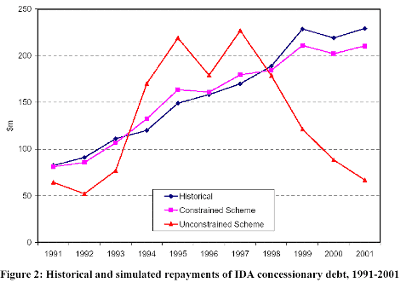The principal cost of the schemes we have considered is the unsmoothing of flows from borrowing countries to the concessionary lenders. Here, we focus on the impact on IDA, the most important of these lenders. The impact is charted in Figure 2 which looks at Scheme A (swap based) schemes using regression weights. The figure compares the total debt repayments to IDA from the ten countries in our simulation sample in both the constrained and unconstrained cases with actual historical repayments over the simulation period 1991-2001.

There is a stark contrast between the impact of the constrained and unconstrained schemes. The constrained scheme permits only relatively small net departures of debt repayments from their historical time path – the maximum divergence is $19m (in 2001). By contrast, the unconstrained scheme generates much larger divergences - $154m in 2000 and $189m in 2001.
The consequence is that, in 2001-02, under this arrangement IDA would have received only one third of historical debt service payments. One reason for the large size of these figures is that there is relatively little offsetting – there is a large common factor in commodity price cycles. Net flows average 69% of gross flows in the constrained scheme and 65% in the unconstrained scheme21.
These results necessarily indicate a major question mark against the scheme using trend export revenues as the instrument. Table 1 suggests that the potential benefits from the unconstrained scheme are perhaps two to three times those from the constrained scheme. However, the disruption of IDA finances is many times larger than this.
The choice therefore appears to be between a scheme which imposes a relatively small disruption on IDA finances but which generates a low expected level of benefits to participating countries, and an alternative which imposes much greater disruption on IDA for benefits which, although larger, remain low.
21 The main element of offsetting in our sample comes from Cameroon whose oil export revenues are negatively
correlated with commodity export earnings and oil import expenditures in the other countries in our sample. We
note that the poor quality of published oil import statistics makes it difficult to estimate appropriate hedge ratios
for oil imports and may also result in underestimation of the beneficial effects of the schemes we investigate.
Information is even less complete for the value of oil exports. Cameroon is the only country we consider which has significant oil exports. In a number of years, valuation of reported tonnages of oil exported from Cameroon
at world prices gives figures in excess of the reported dollar value of total Cameroonian export revenues.
By Prof. Christopher L. Gilbert, Prof. Alexandra Tabova
Next: Discussion
Summary: Index